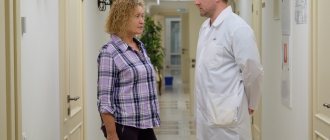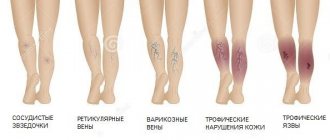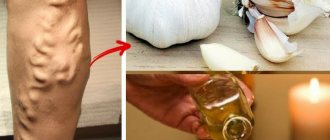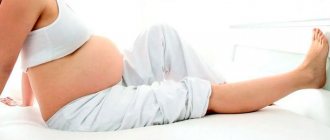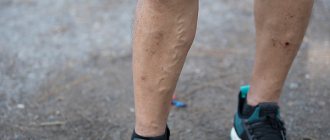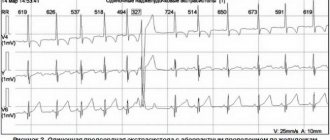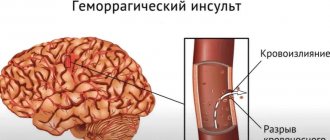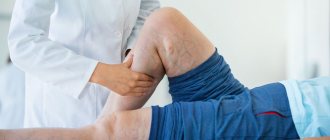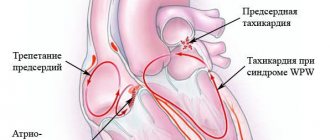Protruding veins are an important symptom of varicose veins: the walls of the veins irreversibly change their structure and lose elasticity, persistent pathological bends and nodular areas appear on them. Valve failure occurs, resulting in the development of chronic venous insufficiency and its complications.
Varicose veins are not a congenital pathology; its symptoms appear throughout life. Let's consider the reasons for the visible appearance of veins.
Watch the video!
Phlebologists talk about the causes of varicose veins, the appearance of protruding veins on the legs - information based on evidence-based medicine and real practical experience.
Protruding veins on the legs do not look aesthetically pleasing. Leg injury and lack of treatment pose a serious threat to health.
A pathogenetically significant difference between humans and animals is upright walking. The predominantly vertical position of the body in people is the main factor contributing to the development of varicose veins of the lower extremities.
The human venous system is located virtually vertically, without obvious bends in the frontal plane. The column of blood flowing to the heart in humans is much higher than in animals. It exerts significant pressure on the walls of the vessels of the distal parts of the venous system, which is explained by the action of gravity. As a result, the superficial veins of the lower extremities and the valves located in them constantly experience increased stress.
This situation is aggravated by the lack of an external compensating mechanism: subcutaneous fat and highly extensible skin of the legs are not able to provide sufficient resistance if the superficial veins begin to dilate. In animals, these vessels are pressed against the fascia much more tightly, since they are not characterized by the presence of a fatty layer on the extremities - this reduces the likelihood of pathological dilatation of blood vessels.
Almost all people can be considered predisposed to developing varicose veins. But it should be understood that all this in itself does not lead to permanent changes in the walls of blood vessels and the appearance of protruding veins. But the additional impact of other factors can become a destabilizing moment and trigger the process of varicose veins of the lower extremities.
Causes
Many people call varicose veins a disease of modern society. In fact, it has been known for a long time. Even in the treatises of ancient doctors there are descriptions of its characteristic symptoms and attempts to rid patients of this disease. But scientists began a targeted study of the etiology and pathogenesis of varicose veins not so long ago. And at present, quite a lot of factors have been identified that play a role in the development of this pathology. But it is impossible to call any one of them unambiguously leading to varicose veins.
A person can be exposed to several potentially harmful factors simultaneously, but not suffer from venous pathology. And what led to the debut of varicose veins in one patient may not affect the health status of another. Therefore, even in the presence of several unfavorable factors (in the absence of signs of venous pathology), doctors only talk about predisposition. Such a patient is considered to be at increased risk for the development of varicose veins, and during preventive examinations, special attention is paid to the condition of his legs.
All causes of varicose veins can be divided into (1, 2, English):
- external (exogenous);
- internal (endogenous), that is, created in the human body itself.
In the vast majority of cases, factors are combined and complement each other. Some of them are considered irremovable. The majority can still be corrected, which reduces the likelihood of early onset and rapid progression of venous pathology. And the maximum possible elimination of such factors lies at the basis of primary and secondary prevention of varicose veins.
What factors cannot be corrected?
Unavoidable causes are considered:
- Ethnicity. Some races are less likely to develop varicose veins, even if they have other risk factors. For example, this disease has a very low prevalence among indigenous people of Africa, New Guinea, and the northern subpopulations of India. In Europe, about 80% of the population has signs of varicose veins.
- Female. According to world medical statistics, the ratio of men and women of reproductive age suffering from varicose veins is approximately 1:3.
- Heredity. Varicose veins are considered as a genetically determined pathology with a polygenic mode of inheritance. The structural features of the venous system, the number of valves, the composition of the main structural proteins of connective tissue and other factors can be passed on to descendants (3, English). Therefore, if the family history is burdened with varicose veins in relatives of the 1st and 2nd lines of kinship, the likelihood of developing this disease increases significantly. But this does not mean that children from parents with vein pathology will necessarily suffer from the same problem.
- Elderly age. As tissues age, the amount of structural proteins (collagen, elastin) decreases, which is accompanied by a decrease in their elasticity and adaptability to stress. The same changes occur in the walls of blood vessels. Women also have an additional varicose factor - pronounced changes in hormonal levels during premenopause and menopause.
Despite the presence of such fatal factors, not all people develop varicose veins. And the timing of the onset of symptoms in patients can vary significantly. This is explained by the polyetiology of the disease and the great importance of many other factors.
Causes and provocateurs of varicose veins
The main predisposing and provoking causes of varicose veins include (4, English):
- Pregnancy is a powerful provoking factor. The increased risk of varicose transformation during gestation is due to significant changes in hormonal levels and difficult outflow in the inferior vena cava system. Most often, changes in the veins appear in the 2nd and 3rd trimesters, when the growing uterus begins to compress the pelvic vessels. A large fetus, polyhydramnios, multiple pregnancies, a combination of pregnancy and myomatosis significantly increase the likelihood of developing varicose veins.
- Taking medications based on sex hormones (in women). Oral contraception, hormone replacement therapy for decreased ovarian function, and hormonal treatment for certain tumors are considered a high risk factor for the development of varicose veins.
- Excess weight and associated metabolic disorders. Excessive body weight is associated with increased stress on the heart muscle. Obesity leads to a decrease in the suction force of the right side of the heart with a tendency to stagnation of blood at the periphery of the venous system. Overweight people often experience a lack of physical activity, which results in insufficient muscle pump performance in the lower extremities.
- Any conditions that lead to obstruction of outflow in the inferior vena cava system. The pathogenesis of such disorders may include mechanical compression of the pelvic vessels and increased intra-abdominal pressure. Chronic constipation, pregnancy, pelvic mass formations, megacolon, chronic obstructive pulmonary diseases (COPD) with frequent cough and flattening of the dome of the diaphragm are often the causes of varicose veins.
- Venostasis. Inactivity, prolonged sitting - all this slows down the outflow of blood from the lower extremities.
The more pronounced predisposing factors, the higher the likelihood of early onset of peripheral venous pathology and the rapid course of the disease.
Why are women prone to varicose veins?
Varicose veins are diagnosed in women in approximately half of clinical cases. Reasons (5, English):
- Gender differences in endocrine status. The estrogen-gestagen hormonal background in women of reproductive age is the main predisposing factor to varicose veins.
- Features of the structure of subcutaneous fat tissue.
- The addition of other risk factors: pregnancy, oral contraception, and often hormone replacement therapy.
Female sex hormones affect the condition and tone of the vascular walls, promoting their expansion. Particular importance is attached to progesterone, the hormone of the second phase of the menstrual-ovarian cycle: its relaxing effect on the smooth muscle muscles of not only the walls of internal organs, but also blood vessels has been proven. Promotes venostasis. This is why many women more often complain of heaviness in their legs at the end of the ovarian-menstrual cycle, when the dominant sex hormone is progesterone.
Estrogen also affects the condition of the vein walls, although to a lesser extent; its varicose effect can be both direct and indirect. Estrogens can increase the likelihood of immune complexes being deposited in the walls of the veins, which leads to their thickening and decreased elasticity. They also provoke vasodilation.
The indirect varicose effect of estrogens includes an increased tendency to intravascular thrombus formation.
Combined changes in the hemostatic system include:
- increased fibrinogen levels in the blood;
- increased platelet aggregation even in the absence of violations of the integrity of the vascular endothelium;
- change in the ratio between various coagulation factors.
In healthy women not taking any medications, this tendency to form blood clots is minimal and has no particular clinical significance. The hemostasis system is able to compensate for it. But when other factors affecting hemostasis are added, the natural balance between thrombus formation and thrombolysis is disrupted, and blood viscosity increases. And in women this usually happens faster than in men.
Destabilizing prothrombogenic factors include:
- taking estrogen-based drugs for therapeutic purposes;
- use of COCs (combined oral contraceptives);
- liver diseases;
- various intoxications, often occurring with blood thickening;
- pregnancy.
Another factor that increases the likelihood of developing varicose veins in women is the structural features of subcutaneous fat. It is usually looser than in men, with a small number of connective tissue septa, and is prone to the accumulation of extracellular fluid with the formation of edema.
In most women, the external “framework” around the saphenous veins is not able to restrain their deformation with the appearance of characteristic nodes and curvatures. If there is a concomitant difficulty in lymphatic drainage from the lower extremities, the risk of developing varicose veins increases even more.
Pain in veins
We found out that the reasons for the appearance of veins in the legs is the stretching of their walls. But the consequences of varicose veins can be very different: as a result of the activation of leukocytes, inflammation begins on the inner wall of the vein, tissue nutrition is disrupted, and at a later stage the formation of blood clots may begin.
Patients often complain that protruding veins hurt. Unfortunately, we may simply not pay attention to the first manifestations of this symptom and begin to sound the alarm only when the pain brings severe discomfort. Veins hurt due to overstretching: this irritates the receptors located on the inner wall of the vessel. When the disease reaches a serious stage, the discomfort intensifies due to compression of the nerves that pass next to the veins.
Enlarged veins must be treated, since this disease cannot go away on its own.
Consequences
Varicose veins of the lower extremities are usually prone to progression. The initial stages with minimally expressed clinical symptoms and compensated venous insufficiency gradually transform into complicated forms of the disease. Of course, this is accompanied by significantly pronounced external unattractive changes. Bluish nodes protruding under the skin, uneven hyperpigmentation of the skin and often appearing spider veins are far from the most unpleasant possible consequences of the disease.
Varicose veins of the lower extremities are fraught with the addition of chronic venous insufficiency. The explanation for this lies in persistent and gradually increasing hemodynamic disturbances that arise as a result of an increase in the diameter of the affected veins.
Varicose deformation of venous vessels leads to functional failure of the valves located in them. Natural obstacles to the reverse flow of blood disappear, conditions are created for its pathological deposition in the distal parts of the extremities. Such pathological discharge usually first occurs only in the superficial venous system; it is called vertical reflux. Subsequently, incompetence of the valves of the perforating veins occurs, which provide communication between the superficial and deep veins of the lower extremities. Horizontal reflux occurs, which significantly aggravates the existing venous insufficiency and increases the likelihood of complications.
The danger of varicose veins symptoms
Possible consequences of varicose veins include (6, English):
- Persistent manifestations of chronic venous insufficiency in the form of swelling, cramps in the leg muscles, discomfort and pain in the legs and feet.
- Trophic disorders of the skin and soft tissues of the legs up to the development of poorly healing trophic ulcers.
- Infectious and inflammatory changes in the skin, usually occurring against the background of existing trophic disorders. A typical example of such complications is venous eczema.
- Thrombosis and thrombophlebitis of superficial and deep veins, which is fraught with thromboembolism of the pulmonary artery and vital organs. And when a deep vein is blocked, venous gangrene can develop, requiring amputation of the affected limb.
It is difficult to predict when a particular patient will develop complications. Elimination of obvious provoking factors will not lead to a cure and will not contribute to the restoration of the normal structure of the vascular walls. Once varicose veins appear, they will not disappear, although the symptoms may be alleviated due to temporary compensation of venous insufficiency.
What method can cure small purple veins on the legs?
Fortunately, there is a method of treating reticular varicose veins that will allow you to forget about all the cosmetic manifestations of the disease without pain and in just 15 minutes. This method is called Sclerotherapy.
During the procedure, the doctor injects a special drug into the vessel on the leg with a very thin needle. Due to it, a chemical reaction occurs inside the vein. Ultimately, the venous walls “stick” to each other under the influence of the drug. In this case, the drug is not absorbed at all, but acts only locally.
The patient does not feel any unpleasant symptoms during the process. After the small purple veins on the legs are treated with Sclerotherapy, an elastic bandage for varicose veins or compression stockings are applied to the lower limbs.
You can return to your usual activities immediately on the day of the procedure, but to achieve maximum effect you should give up the following for 2 weeks:
- Thermal effects on the legs. Sudden changes in temperature, hot bath, sauna, etc. ;
- High-heeled shoes;
- Sunbathing and visiting the solarium;
Small purple veins on the legs in the ankles, shins, under the knees and on the thighs are a clear sign of varicose veins. Be sure to consult a doctor to quickly and painlessly return your legs to a healthy appearance.
Treatment
Traditionally, all methods of eliminating protruding veins - treating varicose veins - are divided into conservative and surgical (7, English).
Non-invasive methods for treating varicose veins:
- taking medications (phleboprotectors, phlebotonics, disaggregants, anticoagulants);
- physiotherapy;
- compression therapy (wearing specialized compression hosiery);
- exercise therapy;
- Normalization of body weight, correction of hormonal levels, elimination of other provoking factors (physical inactivity, constipation, etc.).
Therapeutic measures are not able to relieve the patient of varicose veins, although they can alleviate his condition, reduce the severity of symptoms and reduce the risk of complications. They are also unable to prevent further progression of the disease.
Classic surgical methods are crossectomy, combined phlebectomy, miniphlebectomy. Flaws:
- traumatic;
- use of general or spinal anesthesia;
- hospitalization;
- discomfort in the early postoperative period;
- long-term rehabilitation.
Currently, radical treatment no longer necessarily means the presence of postoperative scars and long recovery. You can safely get rid of varicose veins using cryosclerotherapy, laser obliteration and RFO.
How to prevent the development of varicose veins?
Primary prevention of varicose veins is the maximum possible correction of existing risk factors, eliminating the causes of the disease that can be influenced (8, English).
Prevention of varicose veins
Main methods of prevention:
- increasing general physical activity, including “physical exercise minutes” in the daily routine, and walking daily;
- normalization of body weight;
- timely treatment of developing dishormonal conditions, careful selection of oral contraceptive and replacement therapy regimens;
- treatment of diseases accompanied by increased intra-abdominal pressure, prevention of constipation;
- detection and treatment of tumor diseases of the pelvis and abdominal cavity.
Body weight control, proper nutrition, and regular physical activity as indicated are the basis for the prevention of varicose veins.
If there is a family predisposition to varicose veins, during pregnancy, while taking oral contraceptives, it is advisable to undergo regular preventive examinations to monitor the condition of the veins of the lower extremities.
Author of the article: Letunovsky Evgeniy Anatolyevich Last update: 09/28/2020.
Causes and prevention of varicose veins of the lower extremities
The causes of varicose veins in most cases lie in a sedentary lifestyle: we spend a long time in a static position (especially sitting), and do not give the necessary stress to our muscles. The following risk factors may also affect:
- excessively tight clothing (pants, socks),
- uncomfortable shoes (especially high heels),
- disturbances in hormonal balance,
- frequent hot baths, sauna visits,
- prolonged serious physical activity, heavy lifting,
- obesity.
The main prevention of varicose veins is maintaining a healthy lifestyle. Even if you have a sedentary job, try not to sit without moving for several hours in a row: get up, stretch your legs, walk more; and don’t forget about a balanced diet, which, along with moderate physical activity, will protect you from many diseases.
Pregnancy is also one of the serious risk factors for varicose veins. But genetic predisposition is still being studied, and there are even a number of studies that refute it.
